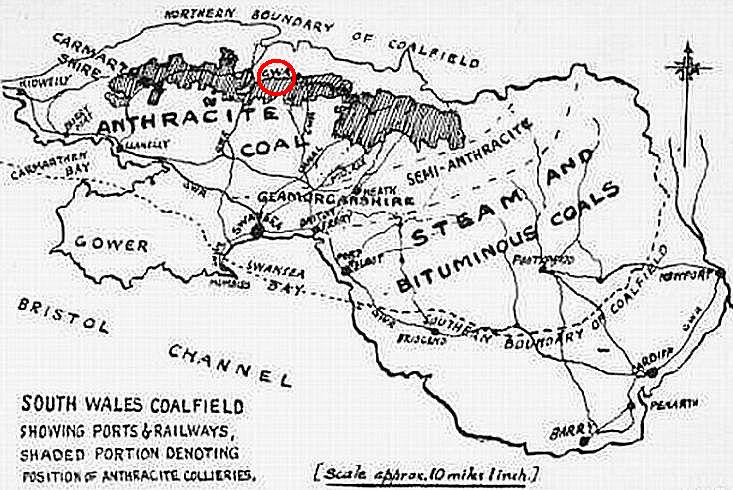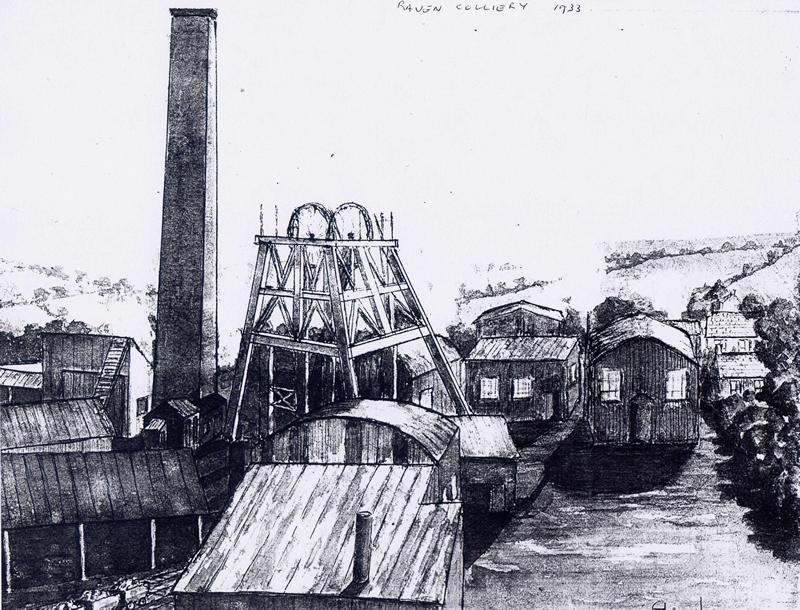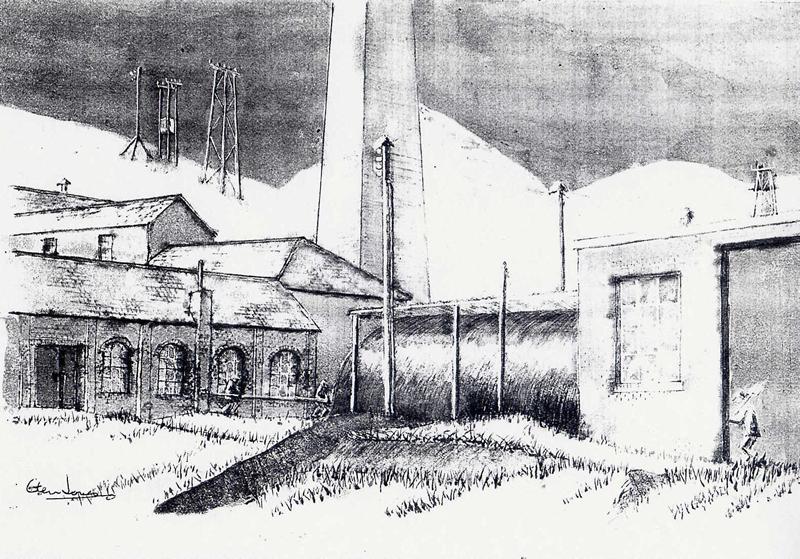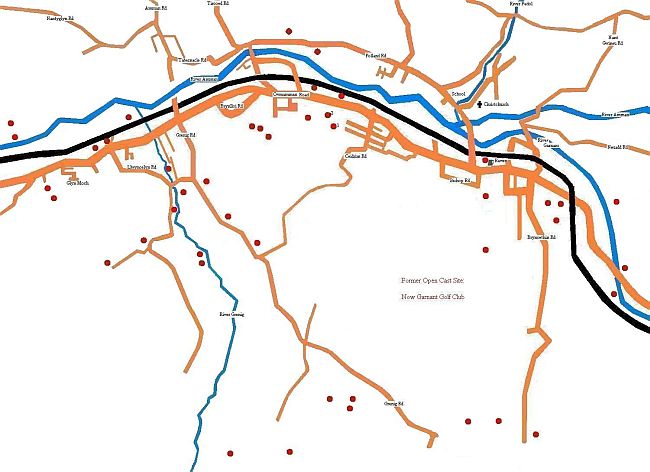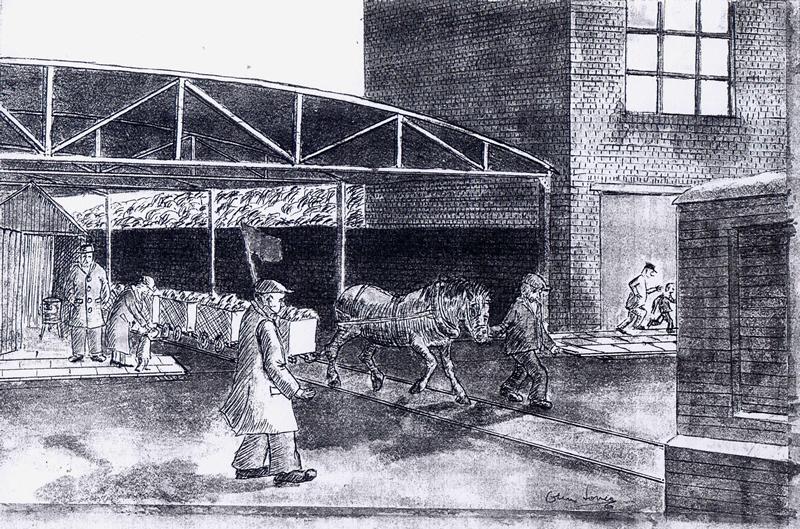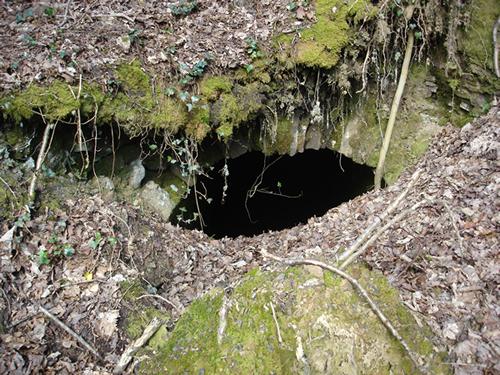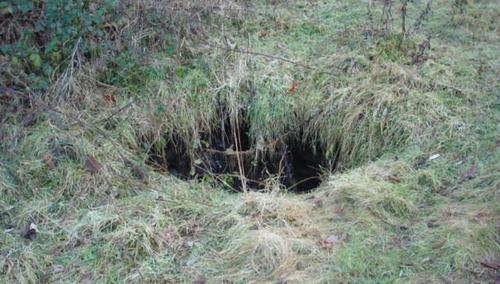Some Captured History of Glanamman and GarnantCoal Mining at CwmammanCwmamman lies in the western part of the South Wales Coalfield; an area rich in hard, compact anthracite coal. The high carbon content and relatively low level of impurities of anthracite make it ideal for domestic burning as well as for other purposes generally associated with coal, such as gas production. Welsh anthracite contains up to 94 per cent carbon, gives off little smoke and ash, is slow burning and gives off an intense heat, making it more economical to use than the softer bitumous coals found elsewhere. It was the outstandingly high quality of the anthracite and the ability to get it to the ports for export that made South Wales anthracite so important. The South Wales Coalfield with the approximate location of Cwmamman shown by the red circle. Coal was originally used in Cwmamman on a very small scale, with local people obtaining the coal for domestic use from where it outcrops at the surface. The oldest coal mine in Cwmamman was reputedly sited at Brynlloi, Glanamman and dates as far back as 1757. The workings were probably driven into the side of the hill and the coal brought out on a wooden barge via a canal. The only evidence today is the reference made in an essay written by D. Trumor Thomas in 1894, titled "Hên Gymeriadau Plwyf y Betws". The essay states that the oak barge was still kept in the barn at Brynlloi Farm. The old Brynlloi Farm was demolished in 1906. Although no evidence can today be seen of the original 18th century mine, there is visible ground disturbance caused by later coal workings near the site of the original farmhouse. In 1830, an advert appeared in the "Cambrian" newspaper,
advertising "Garnant Colliery" for letting. The lease was
to include all of the coal seams under Gors-y-Garnant and Cwmgarnant
farms. The coal seams were advertised as between 3 to 6 feet (1 to 2
metres), thick and supposedly of the best quality in the country. A nearby site formally named "Garnant Colliery" was the location of the Amman Valley's worst mining accident on the 16th of January 1884, when the rope holding the cage broke and 10 men (3 were only 14 years old), were killed. It is not clear which of the two "Garnant Colliery" sites was also known locally as "Pwll Perkins" after the family who once owned it, though it is likely to be the latter. Other collieries were working in the same area in the first half of the 19th Century and evidence of this is provided by another advert in the "Cambrian" newspaper from 1845. An advert for the lease of the Red Lion public house (then sited across the road from Garnant Colliery), stated that it was within 500 yards (or metres), of Garnant Colliery and in the immediate neighbourhood of Messrs. James and Aubrey's and other extensive works. Old ordnance survey maps of Cwmamman show the scale of coal mining in the vicinity. There are countless old coal workings, many of which are nameless and many more went unrecorded, becoming lost in the mists of time. Many small collieries ceased working before regulations stated that site closure plans, showing tunnels and mine workings were to be submitted to a regulating body. The plans that were submitted are now in the possession of the Coal Authority. The larger, more important collieries are still well known today and the two most important of these were "The Raven" and "The Gellyceidrim". By 1854, a colliery had opened at "The Raven", Garnant and the arrival of the Railway in 1840 meant that coal could be easily transported from Cwmamman to the docks at Llanelli. A new pit was sunk in 1907, which was 30 yards (Metres) deep connecting to a drift which lead to the coal face. By the start of the first world war, there were reputedly 450 men employed at the Colliery, making it the one of the most important mines in Cwmamman. Like many collieries, the ownership changed hands on several occasions, before the colliery closed permanently in 1936 after an industrial dispute. The site is now an industrial park, with a doctors surgery and Day Centre nearby.
More information regarding the Raven Colliery is available on a separate web page. In 1891, the Gelliceidrim Collieries Company opened what became the largest of the coal mines in Cwmamman, which in 1934, employed 632 men. Mechanisation of the mine in 1949 meant an increase in production with a smaller workforce. In 1955, the annual output of Gellyceidrim Colliery reached 30,811 tons, with a workforce of 257 men; 112 of whom worked at the coalfaces. The Gellyceidrim colliery consisted of two drift mines; the No. 1 slant ceased to be worked within 3 years of the No. 2 slant opening but was later re-opened to be used for pumping water from the mine. The No. 2 slant was opened to work the Tyllwyd seam in 1924. The ownership of the company changed hands several times during the life of the colliery which was Nationalised in 1947. The National Coal Board closed "The Gelly" permanently in 1957. The enormous coal tips from the Gellyceidrim works were removed and the location is now a local beauty spot known as Parc Gelliwerdd.
More information regarding the Gellyceidrim Colliery is available on a separate web page. In 1927, a £5 million merger between the Amalgamated Anthracite Collieries Ltd. and the United Anthracite Collieries Ltd. took place. The manageing director of the joint undertaking was Sir Alfred Cope, former deputy-chairman of the Amalgamated Anthracite Company. In March of 1927, before the merger had taken place, Sir Alfred Cope stated that the combined output would exceed 40 per cent of the total output of Welsh anthracite, which was recognised throughout the world as the best anthracite produced. He also stated that at that time, Wales produced 4½ million tons per year and that the new amalgamation would produce upwards of 2 million tons. The new amalgamation would consist of 21 collieries; all of which were situated in the South Wales anthracite area. Gellyceidrim was one of the collieries included in this amalgamation. Some other Collieries worked at Garnant and Glanamman are listed below. The general direction of the mine workings at Cwmamman is South. Cawdor Colliery, Garnant (Above Bryncethin Road towards Gwaun Cae
Gurwen). The image below shows the approximate locations of some of Cwmamman's coal mines. The image does not show the plethora of old pits and air vents which were scattered throughout the area in the 19th century. Please click on the image to enlarge. The effect on the landscape was dramatic. Today, it is difficult to imagine the black coal tips which were extensive. Local rivers were tainted with the coal dust they carried downstream. The engine houses of the Raven and Gellyceidrim Collieries each held tall chimney stacks. Tram lines crossed the main road through the valley and in the 1930's, a man with a red flag would stop the traffic for the trams to cross over to the train sidings near to where the Amman United Rugby Club is situated.
The countryside still holds open pits which were either never filled or which have subsided. Occasionally, property damage occurs from old underground workings. There were also many ventilation shafts and drifts which are not completely closed or filled, causing a danger to both humans and animals.
The amount of work available in Cwmamman meant a large influx of workers and houses were needed for them to live in. The table below shows the number of people in Cwmamman's Ecclesiastical Parish, which was also made up of the village of Gwaun-cae-gurwen.
Statistics from Carmarthenshire County Council show that the population of Glanamman and Garnant in 2001 was 4,230; making up 1,817 households. The growth of population in Cwmamman also resulted in the building of schools and places of worship; as well as the need for shops, public houses, doctors and policemen. Other important issues which arose from the population growth was the need for sufficient clean water and sewerage removal. Before the First World War, most of the anthracite from the South Wales Coalfield went to France, Italy, Germany and Scandinavia, but the demand for British coal waned in the early part of the 20th century due to fierce competition from other countries. Temporary closure of local collieries was not unusual during this time and this had a detrimental effect on the local economy, when the colliers were rendered unemployed. The Amman Valley Chronicle contained the following brief paragraph in it's 15th January, 1914 edition: "The industrial outlook of the district is gloomy in the extreme. The majority of the works are idle and large numbers of people are out of employment." During this period, collieries at the eastern end of the South Wales Coalfield, which produced the softer bitumen and steam coal, struggled to survive due to lost markets abroad and also because the Royal Navy and Merchant Navy changed from steam power to oil fuel in their ships. The First World War saw foreign markets being affected and also a shortage of labour in Welsh coal mines due to so many men joining the army. In 1916, the coal industry was taken over by the government. This was met with the approval of many colliers who for some time had hoped for nationalisation after disputes over pay and hours with the coal owners. Up to approximately 1918, anthracite coal in Britain was used almost exclusively for hop-drying (by brewers) and lime burning; the general public using the softer smoky coal for their house fires. The result was that approximately two thirds of the anthricite produced in Britain was exported, until around 1920, when the benefits of anthracite were brought to the attention of the general British public. Despite the drop in demand for British coal abroad, demand for anthracite coal increased enormously at home by 1921. In London, domestic consumers were paying exorbitant prices (95 or 100 shillings per ton), due to retail merchants charges. Welsh anthracite continued to be exported to Sweden, Norway and Italy in large quantities, who used it for the manufacture of carbide of calcium. In February of 1919, Lloyd George introduced a bill in the House of Commons, to set up a Commission to enquire into every aspect of coal mining and the effect on other industries from the miners demands over working hours and pay. The miners' leaders were in favour of continued nationalisation and stated that the government were causing an unnecessary delay in making a decision, insisting that enough information was already available. The majority of the miners in the Amman Valley were as determined as any in Britain to fight for better conditions in the coal industry and the following list gives the results of a ballot, taken in February 1919, which shows that the vast majority of miners were willing to go on strike.
The total numbers of votes by the whole of the lodges of the Miners' Federation of Great Britain were as follows:
The coal mines were handed back to the coal owners
in 1921 and disputes over pay and other issues were once again causing
hardship in South Wales, with strikes and lockouts taking place.
This reached a crisis point in 1926 when a general strike took place
in Britain. This came about mainly due to the lack of European demand
for British coal in 1925. Put simply; the amount of coal produced
by Britain and other countries created a surplus of coal in Europe,
which caused the price to drop significantly (at that time, 80%
of British coal was exported to Europe). As Welsh coal was relatively
expensive to produce, due to geological conditions, the coal owners
demanded that the workforce take a large cut in wages and add an
extra hour to each working day. The colliers at the time were paid
on the basis of a "sliding scale", which in simple terms
meant that when the price of coal was high, they were paid more;
but when the price of coal dropped due to market forces, their wages
were less. There were many disputes in the coalfield regarding what
the minimum wage should be. To complicate matters further, the sliding
scale did not apply to all workers. Some surface workers had a different
arrangement which they negotiated with their employer. Such was the hardship in Cwmamman during this period, that in July of 1926 a soup kitchen, run by volunteers was set up at the Palais-de-Danse at Garnant. After the riots which took place in Ammanford in 1925, Carmarthenshire took on an extra 14 police officers, expecting there to be further trouble. At a meeting of the Carmarthenshire Standing Joint Committee in April of 1927, it was decided that for economic reasons, there should be a motion to reduce the number of police officers by not filling the next six vacancies that occurred. The Chief Constable stated that the Force was the minimum required by the Home Office but committee member, Mr. H. V. Watkins of Llandovery, stated that the trouble anticipated in 1926 did not occur and that "never in the history of the world were a more peaceful crowd than the miners of Carmarthenshire during the prolonged stoppage of last year". From 1927 to 1934, British industry as a whole went into terrible decline with closures of mines and iron works which were unable to make a profit. The 12th January 1928 edition of the Amman Valley Chronicle contained the following brief article under the title "Slackness of work": "The New Year has unfortunately made no beneficial change in the working conditions locally. Last week, matters were deplorable, not one of the three local collieries affording a day's work to the workmen employed; all three were idle throughout the week." The number of unemployed rose to 50% in Merthyr and
the rest of the South Wales Coalfield suffered significantly also.
Cwmamman did not escape the depression, though the percentage of
coal miners out of work, when compared to the rest of the South
Wales region was significantly lower. People suffered appalling
poverty during this depression and the poor diet of the population
resulted in an increased incidence of rickets in some areas. Hunger
marches took place, such as the one in 1936, where unemployed men
from South Wales marched to London in protest at the Government.
The outbreak of the Second World War in 1945 once again saw a demand for Welsh coal and a manpower shortage in the industry as a whole due to workmen joining the armed forces. The government again took control of the coal industry in 1942 and introduced the "Bevin Boys" in 1943. Ten percent of 18 year olds were drafted into the coal mines rather than the armed forces. These were not always popular with the regular miners, who were fearful that they would take valuable jobs from regular miners after the war had ended. The Coal Industry Nationalisation Act of 1946 saw the establishment of the National Coal Board (NCB), which run the nationalised (public owned) coal mining industry in Britain. The NCB took over the mines on the 1st of January, 1947. Since that time, Cwmamman has seen the opening and closing of a few small privately owned mines, such as the drift mine on Grenig Road (near to Maesywern Rd, Glanamman), in the 1970's and also an open cast mine at Garnant which contractually opened on the 7th of September, 1987. Production started on the 13th of May 1988, on the site which was 114.65 hectares in size. A total of 440,000 tons of anthracite coal was extracted at an average of 2,000 tons per week, even though only 48 men were employed at the site. The coal seams worked at the Garnant opencast site were the Upper White, Upper Black, Harnlo, Big, Lower Black, Peacock, Trigloin and Upper Pencraig seams. Coal from the site was sent to the Gwaun-cae-gurwen and Cwmbargoed washeries and then used by domestic, export and industrial markets. After the coal workings were completed in December of 1992, the open cast site was redeveloped at a cost of nearly £1 million and is now the site of Garnant Golf Club. Information for this page was taken from a number of sources including "Anthracite and the anthracite industry", by A. Leonard Summers; "People, Politics and Protest", by Gareth Elwyn Jones; Kelly's Directories; "A Brief Survey of the Ecclesiastical Parish of Cwmamman" (1942) by Rev. Tudor O. Hughes; and a composition contributed to the Amman Valley Historical Society by its author, Glenville Jones. Thanks go to Brian Lewis for help with identifying coal mine locations at Cwmamman and to Peter Jones (site surveyor at Garnant Opencast) for his contribution.
|
